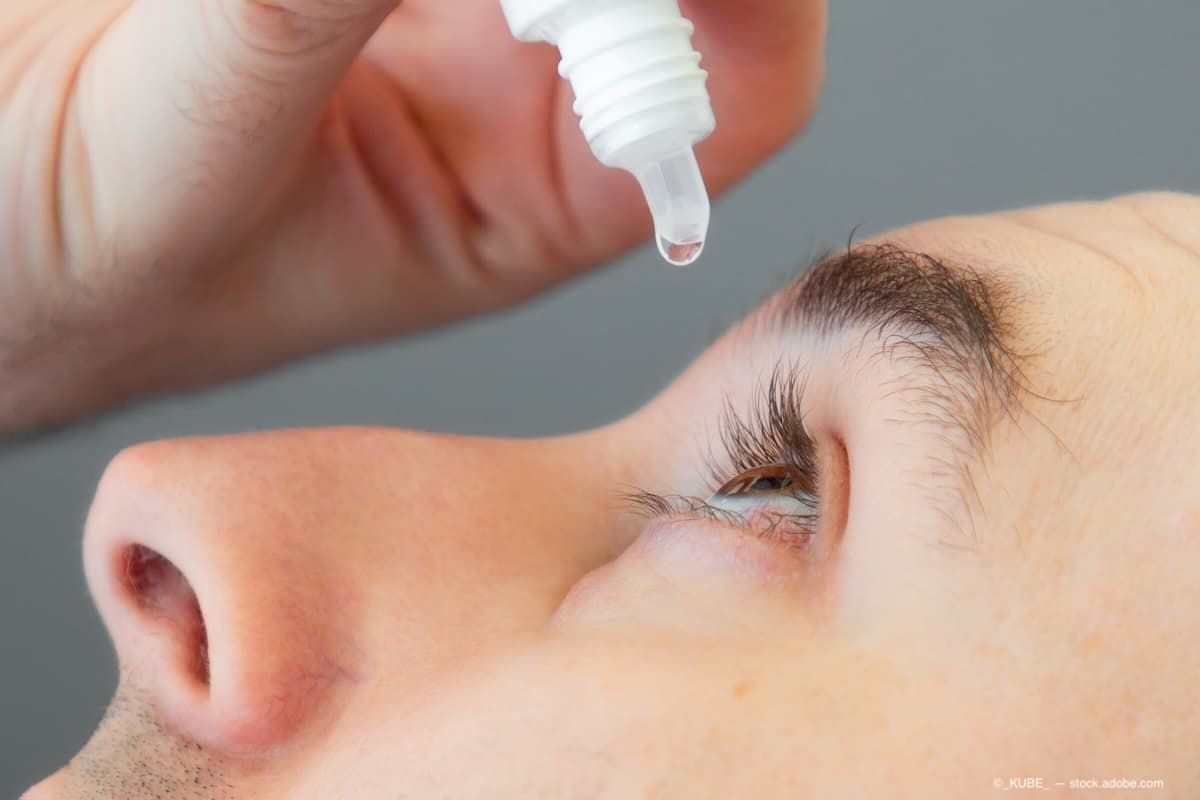Publication
Article
Digital Edition
Investigators zoom in on future of dry eye treatment
Author(s):
Autologous serum eye drops and blood products offer hope to patients.


This article was reviewed by Bennie H. Jeng, MD
There is a place for the use of autologous serum and blood products in the treatment of dry eye disease, and access to these products is improving. However, investigators must first address a few unanswered questions.
Research results
This treatment approach has been around for some time but was not popularized until 1999, when Tsubota et al1 reported that the growth factors and vitamins in the autologous serum eye drops made them beneficial.
“Since that time, there has been a great deal of interest in using autologous eye drops to treat various conditions of the ocular surface,” said Bennie H. Jeng, MD, professor of ophthalmology and chair of the Department of Ophthalmology and Visual Sciences at the University of Maryland School of Medicine in Baltimore.
Related: Advancements in dry eye management
Treating dry eye with autologous serum tears is an area of interest. The disorder is associated with diseases such as Sjögren syndrome, chronic graft- vs-host disease, Stevens-Johnson syndrome, and postkeratorefractive surgery.
A retrospective study showed that fluorescein staining improved in almost 75% of eyes after use of 20% autologous serum and improved subjective symptoms.2
Another retrospective study that evaluated 50% autologous serum also showed improved fluorescein staining, Shirmer, and ocular surface disease index (OSDI) scores.3
A more recent study of 100% autologous serum used to treat severe chronic ocular graft-vs-host disease found no issues with immune complex accumulation and ocular surface inflammation.4
A prospective study that compared 20% autologous serum with preservative-free artificial tears showed that at the 1-month evaluation, the eyes treated with autologous serum had significantly longer tear film breakup time (TBUT) and a greater decrease in the OSDI scores, but the Schirmer scores and Oxford conjunctival and corneal vital dye grading scores did not differ between the 2 treatments, Jeng recounted.5
Related: Glaucoma and dry eye present double trouble for patients, ophthalmologists
To date, only 5 randomly assigned controlled studies (92 patients total) were included in a Cochrane review6 that evaluated autologous serum drops to treat dry eye.
“This study found that there may be some benefit to using autologous serum, but the available evidence was not definitive, and further studies are needed,” he reported.
A 2019 report by the American Academy of Ophthalmology7 agreed that autologous serum drops likely provide some benefit for patients with severe dry eye, but the lack of clinical trials precludes a more definitive role for this therapy.
Unanswered question
The studies performed so far appear to show positive results for the use of autologous serum drops for patients with dry eye, more work must be done before definitive results are reached.
Jeng pointed out areas to be studied, including the best way to process serum, which includes a determination of centrifugation time/speed and clotting time, the serum factors that are most beneficial; and optimal serum concentration.
Related: Examining ocular allergy, quality of life
In addition to the benefits of the serum, harmful effects must be ruled out.
A prospective cross-sectional study8 found that patients with primary Sjögren syndrome treated with autologous serum had significant improvement in ocular symptoms, ocular surface staining, and TBUT, but patients with secondary Sjögren syndrome had no improvement, likely because of the higher serum proinflammatory cytokine levels in those patients, which inhibited a benefit.
Complications such as immunoglobulin deposition, microbial contamination, and viral transmission to processing technicians, cost, and regulatory and legislative restrictions must be considered, Jeng said.
Treatment recommendations
These have changed over time, in that little more than a decade ago, autologous serum tears were recommended for use in severe dry eye cases.
In contrast, the Dry Eye Workshop Study II elevated the use of autologous serum tears to step 3 from the previously recommended last treatment step.
Related: Myths and misconceptions about autologous serum for dry eye
Other blood products in addition to autologous and allogeneic serum are umbilical cord serum and plasma products that include platelet releasate, plasma rich in growth factors, platelet-rich plasma, and fresh frozen plasma.
These have had, in various studies, positive effects in the treatment of dry eye.
The future directions in this area of research include establishing a standardized protocol to manufacture autologous/allogeneic serum eye drops with more consistency and designing large high-quality randomized clinical trials to determine objective markers of success.
“However, even now, I can say that autologous serum and blood products have a role in treating dry eye and access to these products is improving. However, more investigations are needed into the components in the serum to determine which are the most efficacious,” Jeng concluded.
Read more by Lynda Charters
References
1. Tsubota K, Goto E, Shimmura S, Shimazaki J. Treatment of persistent corneal epithelial defect by autologous serum application. Ophthalmology. 1999;106(10):1984–1989. doi:10.1016/S0161-6420(99)90412-8
2. Lee GA, Chen SX. Autologous serum in the management of recalcitrant dry eye syndrome. Clin Exp Ophthalmol. 2008;36(2):119-122. doi:10.1111/j.1442-9071.2008.01680.x
3. Hussain M, Shtein RM, Sugar A, et al. Long-term use of autologous serum 50% eye drops for the treatment of dry eye disease. Cornea. 2014;33(12):1245-1251. doi:10.1097/ICO.0000000000000271
4. Tahmaz V, Gehlsen U, Sauerbier L, et al. Treatment of severe chronic ocular graft-versus-host disease using 100% autologous serum eye drops from a sealed manufacturing system: a retrospective cohort study. Br J Ophthalmol. 2017;101(3):322-326. doi:10.1136/bjophthalmol-2015-307666
5. Celebi ARC, Ulusoy C, Mirza GE. The efficacy of autologous serum eye drops for severe dry eye syndrome: a randomized double-blind crossover study. Graefes Arch Clin Exp Ophthalmol. 2014;252(4);619-626. doi:10.1007/s00417-014-2599-1
6. AuthGraefe’s Arch Clin Exp Ophthalmol 2014;252:619-626.
7. Pan Q, Angelina A, Marrone M, Stark WJ, Akpek EK. Autologous serum eye drops for dry eye. Cochrane Database Syst Rev. 2017;2(2):CD009327. doi:10.1002/14651858.CD009327.pub3
8. Shtein RM, Shen JF, Kuo AN, Hammersmith KM, Li JY, Weikert MP. Autologous serum-based eye drops for treatment of ocular surface disease: a report by the American Academy of Ophthalmology. Ophthalmology. 2020;127(1):128-133. doi:10.1016/j.ophtha.2019.08.018

Newsletter
Don’t miss out—get Ophthalmology Times updates on the latest clinical advancements and expert interviews, straight to your inbox.




